高二英语必修五_名师语法课堂:过去分词作定语和表语用法详解
- 格式:doc
- 大小:79.00 KB
- 文档页数:6


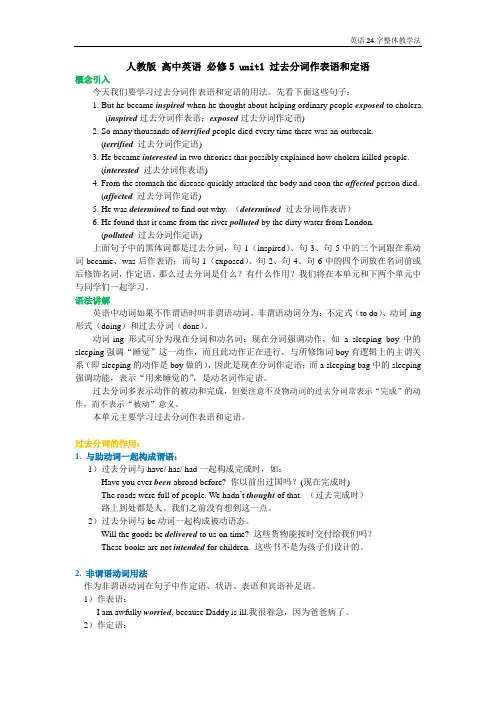
人教版高中英语必修5 unit1 过去分词作表语和定语概念引入今天我们要学习过去分词作表语和定语的用法。
先看下面这些句子:1. But he became inspired when he thought about helping ordinary people exposed to cholera.(inspired过去分词作表语;exposed过去分词作定语)2. So many thousands of terrified people died every time there was an outbreak.(terrified过去分词作定语)3. He became interested in two theories that possibly explained how cholera killed people.(interested 过去分词作表语)4. From the stomach the disease quickly attacked the body and soon the affected person died.(affected过去分词作定语)5. He was determined to find out why. (determined过去分词作表语)6. He found that it came from the river polluted by the dirty water from London.(polluted过去分词作定语)上面句子中的黑体词都是过去分词,句1(inspired)、句3、句5中的三个词跟在系动词became、was后作表语;而句1(exposed)、句2、句4、句6中的四个词放在名词前或后修饰名词,作定语。
那么过去分词是什么?有什么作用?我们将在本单元和下两个单元中与同学们一起学习。
语法讲解英语中动词如果不作谓语时叫非谓语动词。
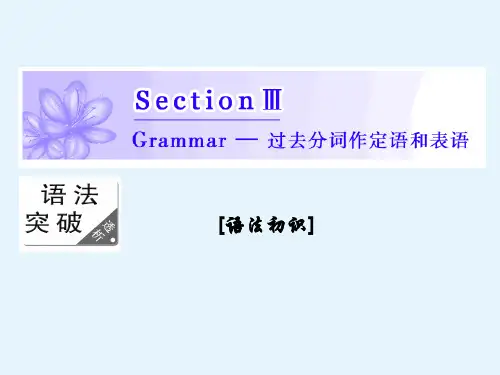
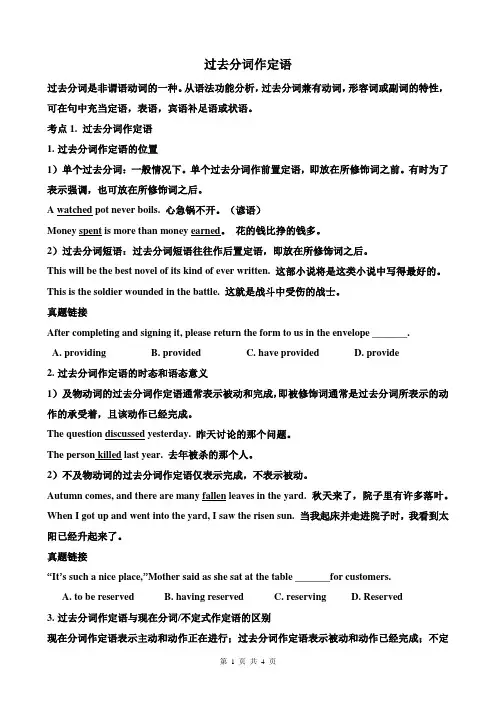
过去分词作定语过去分词是非谓语动词的一种。
从语法功能分析,过去分词兼有动词,形容词或副词的特性,可在句中充当定语,表语,宾语补足语或状语。
考点1. 过去分词作定语1.过去分词作定语的位置1)单个过去分词:一般情况下。
单个过去分词作前置定语,即放在所修饰词之前。
有时为了表示强调,也可放在所修饰词之后。
A watched pot never boils. 心急锅不开。
(谚语)Money spent is more than money earned。
花的钱比挣的钱多。
2)过去分词短语:过去分词短语往往作后置定语,即放在所修饰词之后。
This will be the best novel of its kind of ever written. 这部小说将是这类小说中写得最好的。
This is the soldier wounded in the battle. 这就是战斗中受伤的战士。
真题链接After completing and signing it, please return the form to us in the envelope _______.A. providingB. providedC. have providedD. provide2.过去分词作定语的时态和语态意义1)及物动词的过去分词作定语通常表示被动和完成,即被修饰词通常是过去分词所表示的动作的承受着,且该动作已经完成。
The question discussed yesterday. 昨天讨论的那个问题。
The person killed last year. 去年被杀的那个人。
2)不及物动词的过去分词作定语仅表示完成,不表示被动。
Autumn comes, and there are many fallen leaves in the yard. 秋天来了,院子里有许多落叶。
When I got up and went into the yard, I saw the risen sun. 当我起床并走进院子时,我看到太阳已经升起来了。
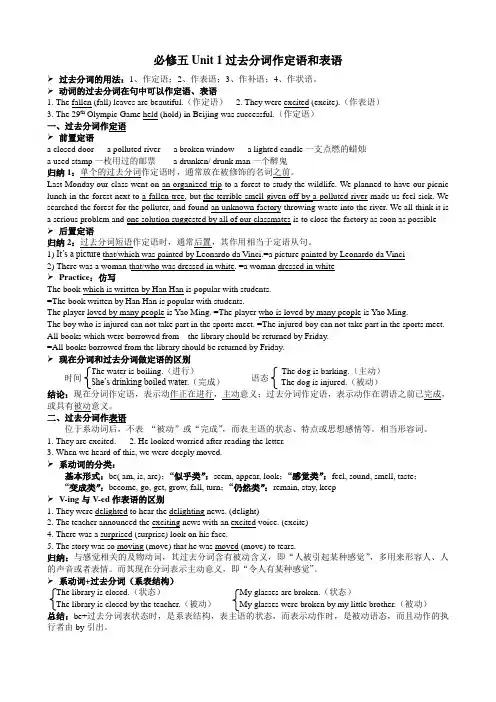
必修五Unit 1过去分词作定语和表语过去分词的用法:1、作定语;2、作表语;3、作补语;4、作状语。
动词的过去分词在句中可以作定语、表语1. The fallen (fall) leaves are beautiful.(作定语)2. They were excited (excite).(作表语)3. The 29th Olympic Game held (hold) in Beijing was successful.(作定语)一、过去分词作定语前置定语a closed door a polluted river a broken window a lighted candle一支点燃的蜡烛a used stamp一枚用过的邮票 a drunken/ drunk man一个醉鬼归纳1:单个的过去分词作定语时,通常放在被修饰的名词之前。
Last Monday our class went on an organized trip to a forest to study the wildlife. We planned to have our picnic lunch in the forest next to a fallen tree, but the terrible smell given off by a polluted river made us feel sick. We searched the forest for the polluter, and found an unknown factory throwing waste into the river. We all think it is a serious problem and one solution suggested by all of our classmates is to close the factory as soon as possible后置定语归纳2:过去分词短语作定语时,通常后置,其作用相当于定语从句。
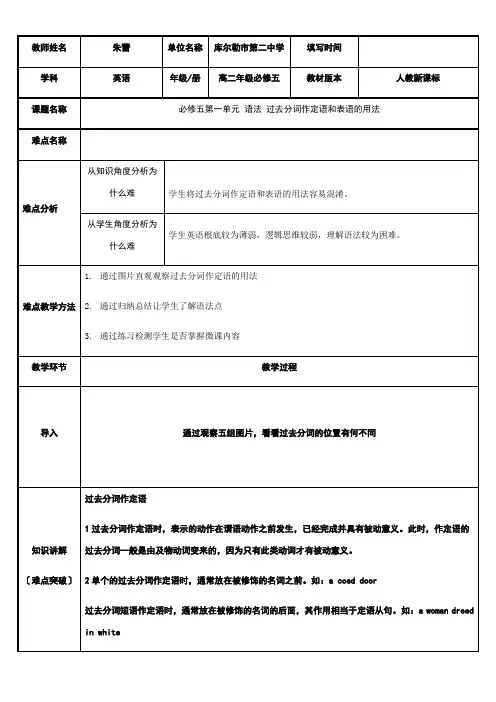
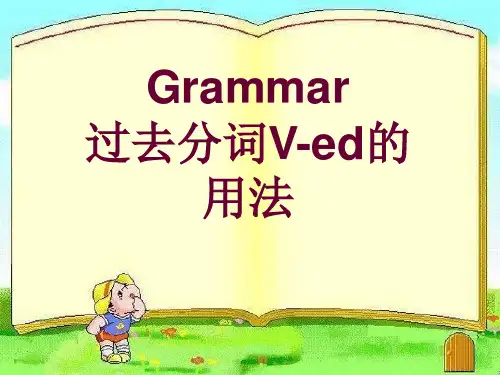
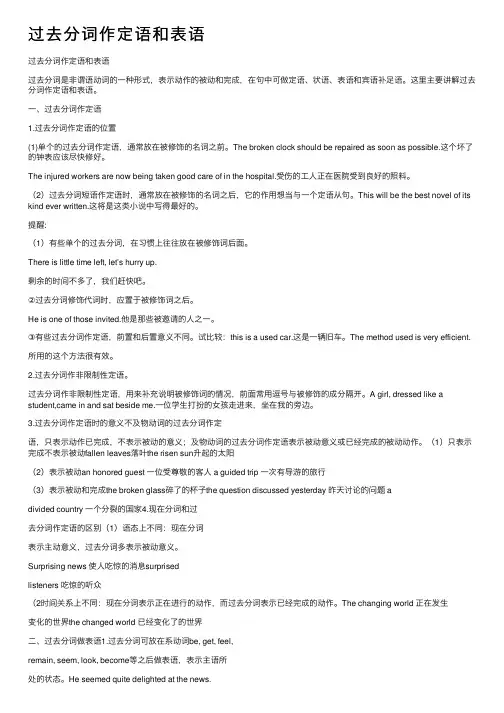
过去分词作定语和表语过去分词作定语和表语过去分词是⾮谓语动词的⼀种形式,表⽰动作的被动和完成,在句中可做定语、状语、表语和宾语补⾜语。
这⾥主要讲解过去分词作定语和表语。
⼀、过去分词作定语1.过去分词作定语的位置(1)单个的过去分词作定语,通常放在被修饰的名词之前。
The broken clock should be repaired as soon as possible.这个坏了的钟表应该尽快修好。
The injured workers are now being taken good care of in the hospital.受伤的⼯⼈正在医院受到良好的照料。
(2)过去分词短语作定语时,通常放在被修饰的名词之后,它的作⽤想当与⼀个定语从句。
This will be the best novel of its kind ever written.这将是这类⼩说中写得最好的。
提醒:(1)有些单个的过去分词,在习惯上往往放在被修饰词后⾯。
There is little time left, let’s hurry up.剩余的时间不多了,我们赶快吧。
②过去分词修饰代词时,应置于被修饰词之后。
He is one of those invited.他是那些被邀请的⼈之⼀。
③有些过去分词作定语,前置和后置意义不同。
试⽐较:this is a used car.这是⼀辆旧车。
The method used is very efficient.所⽤的这个⽅法很有效。
2.过去分词作⾮限制性定语。
过去分词作⾮限制性定语,⽤来补充说明被修饰词的情况,前⾯常⽤逗号与被修饰的成分隔开。
A girl, dressed like a student,came in and sat beside me.⼀位学⽣打扮的⼥孩⾛进来,坐在我的旁边。
3.过去分词作定语时的意义不及物动词的过去分词作定语,只表⽰动作已完成,不表⽰被动的意义;及物动词的过去分词作定语表⽰被动意义或已经完成的被动动作。
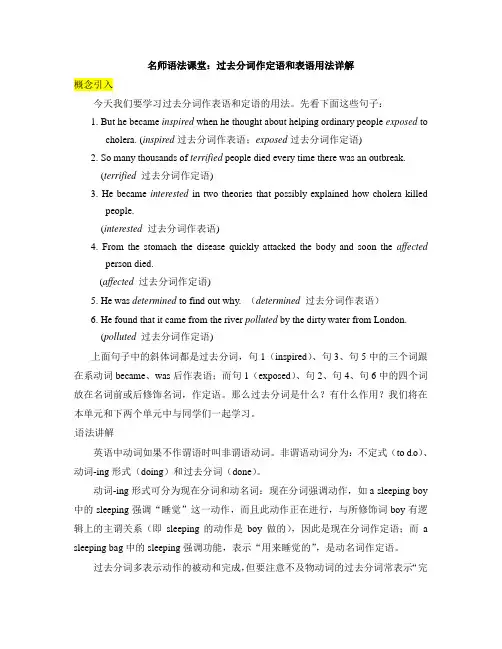
名师语法课堂:过去分词作定语和表语用法详解概念引入今天我们要学习过去分词作表语和定语的用法。
先看下面这些句子:1. But he became inspired when he thought about helping ordinary people exposed tocholera. (inspired过去分词作表语;exposed过去分词作定语)2. So many thousands of terrified people died every time there was an outbreak.(terrified过去分词作定语)3. He became interested in two theories that possibly explained how cholera killedpeople.(interested 过去分词作表语)4. From the stomach the disease quickly attacked the body and soon the affectedperson died.(affected过去分词作定语)5. He was determined to find out why. (determined过去分词作表语)6. He found that it came from the river polluted by the dirty water from London.(polluted过去分词作定语)上面句子中的斜体词都是过去分词,句1(inspired)、句3、句5中的三个词跟在系动词became、was后作表语;而句1(exposed)、句2、句4、句6中的四个词放在名词前或后修饰名词,作定语。
那么过去分词是什么?有什么作用?我们将在本单元和下两个单元中与同学们一起学习。
语法讲解英语中动词如果不作谓语时叫非谓语动词。
非谓语动词分为:不定式(to d o)、动词-ing形式(doing)和过去分词(done)。

过去分词是非谓语动词的一种形式,表示完成和被动的动作。
它在句子中可以充当表语、定语,状语等多种成份。
一、过去分词作定语:过去分词作定语有前置和后置两种情况。
1、前置定语:单个的过去分词作定语,通常放在被修饰的名词之前,表示被动和完成意义。
A类:被动意义:an honored guest 一位受尊敬的客人The injured workers are now being taken good care of in the hospital.受伤的工人现正在医院受到良好的照料。
B类:完成意义:a retired teacher 一位退休的教师They are cleaning the fallen leaves in the yard.他们正在打扫院子里的落叶。
2、后置定语:过去分词短语作定语时,通常放在被修饰的名词之后,它的作用相当于一个定语从句。
如:This will be the best novel of its kind ever written (=that has ever been written).这将是这类小说中写得最好的。
Who were the so-called guests invited (=who had been invited) to your party last night?昨晚被邀请参加你的晚会的那些所谓的客人是谁呀?二、过去分词作表语1、作表语的过去分词主要来自及物动词,在主-系-表句型中,说明主语所处的一种状态。
其中系动词有包括be在内的多种形式。
如:You seem frightened.你看样子受了惊吓。
2、少数不及物动词(如go, come, set)的过去分词也能作表语,但它们不表示被动意义,只是表示动作完成。
如:They are gone for vacation.他们度假去了。
注意:要区别“系动词+过去分词(系表结构)” 和“系动词+过去分词(被动语态)”。
过去分词作定语和表语过去分词具有的性质,同时兼有形容词或副词的性质,在句中可以作、、状语和补足语。
定语——在句中修饰词或词的成分。
表语——是谓语的一部分,位于系动词之后,说明主语身份、特征或状态。
1. a retired teacher ()一位退休的教师2. an honored guest ()一位受尊敬的客人3. The library is now closed. ()图书馆现在关门了。
4. You seem frightened. ()你看样子受了惊吓。
一、过去分词作定语修饰名词或代词1、单个的过去分词作定语一般放在名词的前面,过去分词短语作定语通常放在被修饰的词后面.1.The encouraged people are excited.2. The broken cup is thrown away.3. I want to write stories about people addicted to drugs.4. We are studying in a school built 70 years ago.2、有些过去分词作前置定语和后置定语时意义不同。
in the given time ()with the words given()a concerned look ()the people concerned()a wanted person ()workers wanted ()3、过去分词修饰something, everything, anything, nothing, somebody, nobody等不定代词或指示代词those时,要放在这些词的后面。
He is one of those invited.Nothing reported (in the newspaper) interested him.使用过去分词作定语要注意:(1)及物动词(vt.)的过去分词,既表示被动意思又表示动作的完成;不及物动词(vi.)的过去分词只表示动作的完成。
过去分词作表语和作定语的用法区别过去分词作表语和作定语的用法区别一、注意分清过去分词应前置还是后置一般情况下,单个过去分词作定语通常应该放在被修饰名词之前。
比如This part of the exam requires a written answer. 这部份考题需要书面作答。
Women are limited to the more poorly paid jobs. 女性仅限于做一些薪水较低的工作。
但过去分词短语作定语的话,要放在被修饰名词之后。
比如There is a red car parked outside the house. 房子外边停着一辆红色汽车。
The system used in this school is very successful. 这学校使用的系统很成功。
注意,有时一个过去分词可以在它修饰的词后作定语。
这种情况多是由于特殊原因,比如过去分词修饰的名词或代词可能不适合被介词定语修饰,或者说话人是为了强调动作的时间性,平衡句子结构。
比如The experience gained will be of great value to us. 取得的经验对我们将很有价值。
We couldn’t agree on any of the problems discussed. 我们未能就所讨论的任何问题达成协议。
二、注意分清用过去分词还是现在分词有些成对使用的过去分词和现在分词(如interested与interesting),从用法上看,它们虽然是分词的形式,但具有形容词的特点,都可用作表语和定语,注意它们在用法上的区别:过去分词通常用于说明人自身的感受,通常译为“(人)感到……的”;而现在分词则通常用于说明事物给人的感受,通常译为“令人感到……的”。
如:Interested members will meet at two. 感兴趣的会员两点钟碰头。
The English language has an interesting history. 英语有一段有趣的历史。
过去分词作定语的用法讲解过去分词作定语是英语中一个常见的语法现象,可以表示被修饰词在时间、地点、方式等方面的限制或描述。
下面将详细介绍过去分词作定语的用法。
1. 过去分词作定语的位置过去分词可以放在被修饰词的前面或后面,但通常放在被修饰词的前面。
例如:- The book that I read last year is still in my possession.(我去年读过的书仍在我手里。
)- The car that I bought yesterday is new.(我昨天买的车是新的。
) 需要注意的是,如果被修饰词是名词,则过去分词只能放在其前面。
如果被修饰词是代词或动词,则过去分词可以放在其前面或后面。
2. 过去分词作定语的用法过去分词作定语可以表示时间、地点、方式等方面的限制或描述,其用法如下:- 时间限制:表示时间的限制,例如:- The day that I graduated from college is still a memory in my heart.(我毕业后的那一天我仍然铭记在心。
)- The year that I visited China is a highlight of my life.(我访问中国那一年是我生命中的一个重要年份。
)- 地点限制:表示地点的限制,例如:- The place that I lived for a while is now a favorite spot for me.(我曾经住过的那个地方现在成了我最喜欢的地方。
)- The way that I walk is considered to be a beauty spot.(我走路的方式被认为是一个美丽的景点。
)- 方式限制:表示方式的限制,例如:- The method that we used to solve the problem is still considered to be efficient.(我们解决问题的方法至今仍被认为是有效的。
Section_ⅢGrammar—_过去分词作定语和表语语法图解探究发现①But he became inspired when he thought about helping ordinary people exposed to cholera.②So many thousands of terrified people died every time there was an outbreak.③He became interested in two theories that possibly explained how cholera killed people.④From the stomach the disease quickly attacked the body and soon the affected person died.⑤He was determined to find out why.⑥He found that it came from the river polluted by the dirty water from London.⑦He immediately told the astonished people in Broad Street to remove the handle from the pump so that it could not be used.⑧With this extra evidence John Snow was able to announce with certainty that polluted water carried the germs.[我的发现](1)例句①②④⑥⑦⑧中的过去分词(短语)作定语。
(2)例句②④⑦⑧中为单个的过去分词作定语,常常放于被修饰名词的前面;例句①⑥中过去分词短语作定语,常常放于被修饰名词的后面。
名师语法课堂:过去分词作定语和表语用法详解概念引入今天我们要学习过去分词作表语和定语的用法。
先看下面这些句子:1. But he became inspired when he thought about helping ordinary people exposed tocholera. (inspired过去分词作表语;exposed过去分词作定语)2. So many thousands of terrified people died every time there was an outbreak.(terrified过去分词作定语)3. He became interested in two theories that possibly explained how cholera killedpeople.(interested 过去分词作表语)4. From the stomach the disease quickly attacked the body and soon the affectedperson died.(affected过去分词作定语)5. He was determined to find out why. (determined过去分词作表语)6. He found that it came from the river polluted by the dirty water from London.(polluted过去分词作定语)上面句子中的斜体词都是过去分词,句1(inspired)、句3、句5中的三个词跟在系动词became、was后作表语;而句1(exposed)、句2、句4、句6中的四个词放在名词前或后修饰名词,作定语。
那么过去分词是什么?有什么作用?我们将在本单元和下两个单元中与同学们一起学习。
语法讲解英语中动词如果不作谓语时叫非谓语动词。
非谓语动词分为:不定式(to d o)、动词-ing形式(doing)和过去分词(done)。
动词-ing形式可分为现在分词和动名词:现在分词强调动作,如a sleeping boy 中的sleeping强调“睡觉”这一动作,而且此动作正在进行,与所修饰词boy有逻辑上的主谓关系(即sleeping的动作是boy做的),因此是现在分词作定语;而a sleeping bag中的sleeping强调功能,表示“用来睡觉的”,是动名词作定语。
过去分词多表示动作的被动和完成,但要注意不及物动词的过去分词常表示“完成”的动作,而不表示“被动”意义。
本单元主要学习过去分词作表语和定语。
过去分词的作用:1. 与助动词一起构成谓语:1)过去分词与have/ has/ had一起构成完成时,如:Have you ever been to abroad before? 你以前出过国吗?(现在完成时)The roads were full of people. We hadn’t thought of that. (过去完成时)路上到处都是人。
我们之前没有想到这一点。
2)过去分词与be动词一起构成被动语态。
Will the goods be delivered to us on time? 这些货物能按时交付给我们吗?These books are not intended for children. 这些书不是为孩子们设计的。
2. 非谓语动词用法作为非谓语动词在句子中作定语、状语、表语和宾语补足语。
1)作表语:I am awfully worried, because Daddy is ill.我很着急,因为爸爸病了。
2)作定语:She had a worried look on her face. 她满面愁容。
3)作宾语补足语:She wanted the work finished by Friday. 她要求这工作星期五前完成。
4)作状语:They came in, followed by their wives. 他们走了进来,妻子们跟随在后。
Convinced that they were trying to poison her, she refused to eat anything.她认为他们想毒害她,便拒绝吃任何东西。
过去分词作定语1. 过去分词作定语的位置单个过去分词作定语时,多放在被修饰词前,而分词短语多放在被修饰词后。
Martin’s confused sorrows turned to optimism. 马丁烦乱的悲哀情绪转而变成了乐观情绪。
The play put on by the teachers was a big success. 老师们表演的戏很成功。
注意:有些单个的过去分词,习惯上要放在被修饰词后面;过去分词如果修饰代词时,也多放在被修饰词后。
There is little time left. Let’s hurry up. 剩下的时间不多了,我们赶快吧。
He is one of those invited. 他是被邀请的人之一。
2. 过去分词作定语时的意义:首先我们研究一下这些例句:1)She had a worried look on her face. 她脸上有担心的表情。
2)The frightened horse ran away from the fire. 恐惧的马逃离了大火。
3)She had confused feelings about him. 她对他的感觉有点迷惑。
4)He wore an embarrassed expression. 他一副尴尬的表情。
句1)中worried修饰“look(表情)”。
也许你还记得老师说过:物时要用-ing 形式,人就用-ed形式,初中时老师会这样讲,如:I’m interested in the book.The book is interesting.但是在高中,我们就要思考、分析一下,因为有时事物也会用-ed,而人也可能用-ing。
注意句1),凡是“表情(look/ expression)”一定都是“由里向外”发出的,如:我高兴------pleased look我满意------ satisfied look我担忧------worried look也就是说,自己由里而外的感觉要用-ed的形式。
什么时候人可能用-ing形式呢?如:看到一个可爱的男孩儿跑过来了,我们可以说:The boy is interesting. 再如:She is frightened. -----表示“She”胆子小,很害怕,是内部的感觉;但是如果“She”长得像个妖怪呢?就该是“She is frightening.”了,指的是horrible(吓人的)。
所以-ing形式是“给别人的感觉”,而-ed是内在的感觉。
这是常考的易错点。
句2)中the frightened horse指受到惊吓的马,是马内在的感受;不指马长得难看。
同样,句3)中confused feelings也是指内在的感受;句4)中an embarrassed expression是由于内心的尴尬而发出的表情。
再看下面的短语中的过去分词:the unemployed (未受雇佣的) workers ---- “工人”是“未被雇佣的”the scheduled (依时刻表运行的) train ---- “火车”是被定了时间表的the advertised (广告中的) product ----“商品”是被做了广告the buried (掩埋的) treasure ---- 被埋的珍宝(bury)the injured (受伤的) passenger ---- injure sb./oneself 使某人/自己受伤,乘客“被使受伤”的,此处更强调“完成”fallen leaves ---- fall是不及物动词,fallen此处只表示“完成”小结:1)及物动词的过去分词作定语时,被修饰词经常是过去分词动作的承受者,即逻辑上的动宾关系,此时过去分词表示被动,有时还表示动作的完成。
此时过去分词与其附属成分(宾语或状语等)相当于定语从句。
He found that it came from the river polluted by the dirty water from London (=which had been polluted by the dirty water from London).他发现水是从被伦敦排出的脏水污染了的河里来的。
(表示被动和完成)It’s said that an honoured guest will be here in half an hour. (只表示被动)据说半小时后有位受尊敬的客人就到了。
2)不及物动词的过去分词作定语,只表示动作已经完成。
vanished jewels消失了的珠宝 a retired teacher 一位退休教师3. 现在分词和过去分词作定语的区别:1)语态上的不同注意被修饰词与分词动作的关系:现在分词表示主动,即现在分词动作是被修饰词做的。
过去分词表示被动,即被修饰词是过去分词动作的承受者。
对比:spoken English 英语口语(英语是被说的)an English-speaking country 一个说英语的国家(国家的人说英语----主动)再如:a simply-furnished room 装修简单的房间(房间被装修)a fast developing country 快速发展的国家(国家发展----主动)2)时间关系上的不同现在分词表示正在进行的动作,而过去分词多表示已经完成的动作。
the changing world 正在发生变化的世界the changed world 已经变化了的世界再如:the house being built正在建造的房子the house built in 2010 2010年建造的房子过去分词作表语1. 过去分词放在系动词be, get, feel, remain, seem, become等后作表语, 多为及物动词变化而来的,有被动意味,表示主语所处的状态。
He became annoyed with the students. 他非常生学生的气。
Are you married or single? 你是已婚还是单身?He seems well qualified for the job. 他好像非常胜任这个工作。
2. 少数不及物动词的过去分词也可以作表语,只有完成的意思,也说明主语所处的状态。
Gone are the days(=The days are gone)when my heart was young and gay.我的心又年轻又愉快的日子一去不复返了。